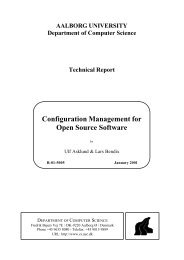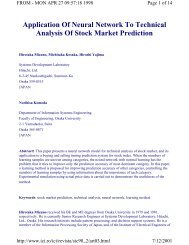ITEM TOOLKIT
ITEM Toolkit Manual
ITEM Toolkit Manual
You also want an ePaper? Increase the reach of your titles
YUMPU automatically turns print PDFs into web optimized ePapers that Google loves.
256 <strong>ITEM</strong> ToolKit Getting Started Guide<br />
• Quantitative estimates of event frequencies or likelihoods and relative importance of various failure sequences<br />
and contributing events.<br />
• Lists of recommendations for reducing risks.<br />
• Quantitative evaluations of recommendation effectiveness.<br />
Event Tree Analysis Process<br />
• Define the system or area of interest. Specify and clearly define the boundaries of the system or area for which event<br />
tree analyses will be performed.<br />
• Identify the initiating events of interest. Conduct a screening-level risk assessment to identify the events of interest<br />
or categories of events that the analysis will address. Categories include such things as groundings, collisions, fires,<br />
explosions, and toxic releases.<br />
• Identify lines of assurance and physical phenomena. Identify the various safeguards (lines of assurance) that will<br />
help mitigate the consequences of the initiating event. These lines of assurance include both engineered systems and<br />
human actions. Also, identify physical phenomena, such as ignition or meteorological conditions that will affect the<br />
outcome of the initiating event.<br />
• Define accident scenarios. For each initiating event, define the various accident scenarios that can occur.<br />
• Analyze accident sequence outcomes. For each outcome of the event tree, determine the appropriate frequency and<br />
consequence that characterize the specific outcome.<br />
• Summarize results. Event tree analysis can generate numerous accident sequences that must be evaluated in the<br />
overall analysis. Summarizing the results in a separate table or chart will help organize the data for evaluation.<br />
• Use the results in decision-making. Evaluate the recommendations from the analysis and the benefits they are<br />
intended to achieve. Benefits can include improved safety and environmental performance, cost savings, or additional<br />
output. Determine implementation criteria and plans. The results of the event tree may also provide the basis for<br />
decisions about whether to perform additional analysis on a selected subset of accident scenarios.<br />
2. <strong>ITEM</strong> ToolKit & Event Tree Analysis<br />
<strong>ITEM</strong> ToolKit Event Tree is an inductive or forward logic method to identify various sequences or set of events, started by<br />
an initiating event, that can lead to certain end consequences or accident scenarios. The idea is based upon the discretization<br />
of the real accident evolution in terms of few macroscopic events. These events are usually characterized in terms of:<br />
• The intervention (or not) of protection systems which are supposed to take action for the mitigation of the<br />
accident (system event tree).<br />
• The fulfillment (or not) of safety functions (functional event tree).<br />
• The occurrence (or not) of physical phenomena (phenomenological event tree).<br />
An event tree begins with a defined accident-initiating event, which could be a component or an external failure. It follows<br />
that there is one event tree for each different accident-initiating event considered. Thereby, all possible responses to the<br />
initiating event are listed from left to right across the page. The branch points on the tree structure usually represent the<br />
success, failure or partial failure of different systems and subsystems which can respond to the initiating event. These event<br />
branches can have their own probability models or can have models derived from attached Fault Trees gates and events.<br />
Theoretically, any probabilistic quantification model, defining the failure (or not) of the system and sub-systems, such as<br />
Predictions, RBD or Markov models can also be used for the quantification of branch probabilities.<br />
In the following example, fire protection is provided by a sprinkler system. A detector will either detect the rise in<br />
temperature or it will not. If the detector succeeds, the control box will either work correctly or it will not - and so on. There<br />
is only one branch in the tree that indicates that all the subsystems have succeeded:




